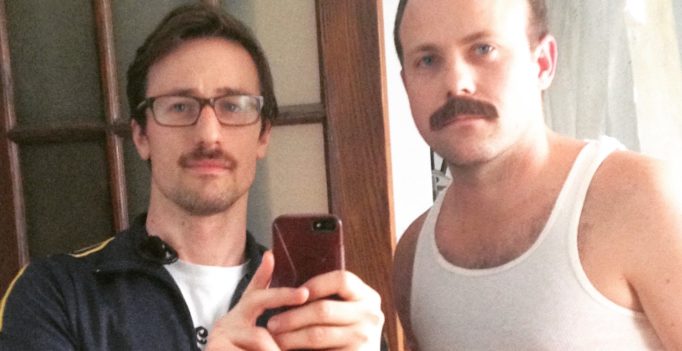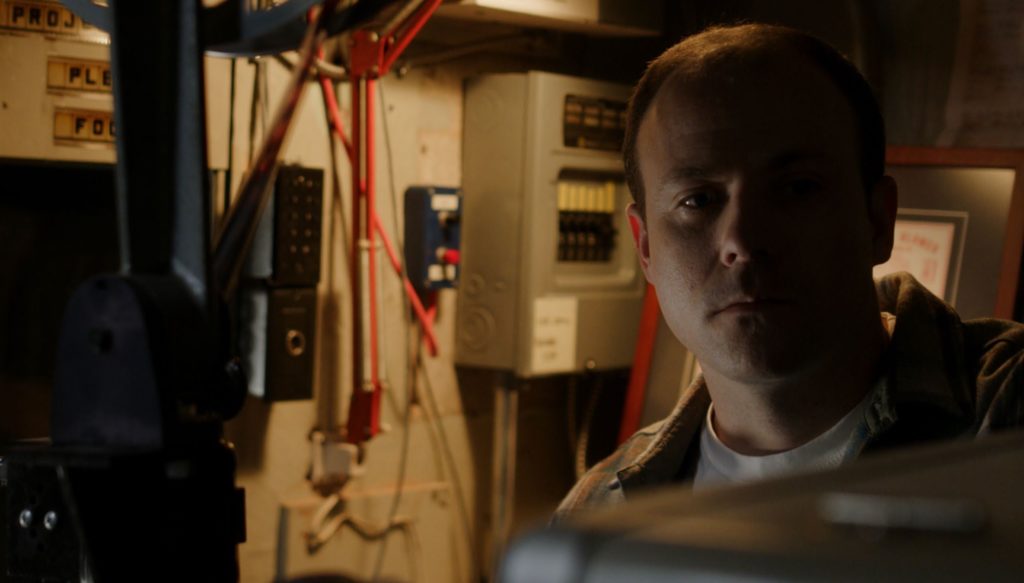Director Kire Paputts follows up his modest feature debut The Rainbow Kid with The Last Porno Show, an envelope-pushing character drama chronicling the personal arc of an aspiring actor taking over his estranged father’s faded adults-only move theatre. It’s a really good movie that doesn’t shy away from anything and bares it all. It stuck to me like shoes to the floor of a sold-out screening room.
After an online sneak preview earlier this year, the film is now available for your viewing pleasure via Vimeo On Demand. I recently picked Paputts’ brain about The Last Porno Show and the controversy that followed his film.
Addison Wylie: How long have you been wanting to tell this story? And, what inspired you to make this movie?
Kire Paputts: The original version of this story started around the beginning of university. Two friends and myself wrote a script that revolved around three characters whose lives become intertwined around a porno cinema. Being young and inexperienced, the script just sat on my computer until 2015 when I decided to revisit it. At this time, I was starting to catch myself doing or saying things that reminded me of my parents. I decided to explore the question of “do we become our parents?”.
I’m also interested in the history of porno cinemas and how they were once a thriving industry as well as a socially acceptable pastime which, over time, became associated with dirty old men in raincoats and gay cruising spots. The only things that made it from the original script to the finished film were the glory hole scene and the Ralf Rhodes character.
AW: The Last Porno Show doesn’t hold back. The film displays male and female full-frontal nudity, unsimulated sex, and deeply uncomfortable situations involving a young child. Some of these factors have even challenged censorship rules. Could you have predicted how controversial your film was going to be?
KP: Is the film controversial? Don’t people need to be talking about your film in order for it to be controversial? Ha ha. I guess I thought the gloryhole scene might bother some people. I wasn’t too worried about the porn or nudity though. The only good thing about not having any money to make a film is that you can do whatever you want. I didn’t have to worry about a bunch of suits telling me what I could and couldn’t do. As a filmmaker, it’s important to tell a story that you find interesting. As soon as you start worrying about what the audience might think, then you’re in trouble.
AW: With so much resistance, what was the most eye-opening disappointment you’ve experienced while making and marketing the film, and what was the most positive, reassuring reaction to your movie?
KP: I knew the film wasn’t going to play on CBC. I also knew I’d have to make some edits in order to have it broadcast on TV (ie. the real porn we use in the film), which I was fine with. However, I was surprised when I wasn’t able to get the film onto the traditional VOD platforms (ie. iTunes, Amazon Prime, etc). I thought it was like the wild West where anybody could sell their film as long as you had a rating for it. Even though I cut out all the hardcore porn, they still had a problem with some of the penis shots not looking flaccid enough. Unfortunately I’m unable to cut out some of these shots. The film just wouldn’t work. There are so many other films that use unsimulated sex that I really didn’t think about it. However, I’ve since discovered that a lot of these films (Love, Shortbus, etc) aren’t on any of the VOD platforms either. The exception being Netflix – they seem to take more chances. Problem is, it’s hard for an indie film, especially Canadian, to end up on Netflix without a distributor who’s dealt with them.
The best reaction is from people who tell me that the film doesn’t feel Canadian.
AW: Has your opinion on censorship changed?
KP: It’s changed a bit. It’s disheartening to think that extreme violence is acceptable while showing specific body parts isn’t. Even when it comes to porn, I’m still surprised by some of the reactions out there. We’re talking about a multibillion dollar industry. People watch porn whether they care to admit it or not. I also realize businesses like iTunes and Amazon Prime should be allowed to program what they want. It’s just unfortunate that they’re behind the times.
I really try not to limit myself. I feel there’s already enough of that happening in film. I’m fully aware that this film isn’t for everybody, but I’d rather have a polarized audience then make something that’s middle of the road. And if I can help change some perceptions or push some boundaries along the way, then fantastic.
AW: A hearty chunk of the story focuses on the art of method acting, and the detriment that follows when a performer gets lost in themselves. Have you always had a fascination with method acting? With the film, I feel like you successfully capture those breakthroughs a performer can have, but you’re also comfortable poking fun at the craft using a self-serious acting coach (brilliantly cast and played by Frank D’Angelo).
KP: I’m very fascinated by actors who take the method approach too far. Not just the stories you hear about famous actors, but also witnessing it first-hand from actors you work with. Problem is unless you know what you’re doing, the method approach can easily backfire. But, like any acting technique, when used correctly it can be magical.
In regards to casting Frank, he was my number one choice. Being a huge fan of his films (Sicilian Vampire and The Red Maple Leaf to name a couple) and knowing how he works, I thought it was the perfect fit. Working with Frank was a challenge for both of us, but in a good way. Frank’s used to filming two features on six cameras over three days. I’m used to filming one feature on one camera over twenty two days. Our directing styles couldn’t be more different, but I feel like I learned a new skill set just within the few hours we worked together.
AW: Torontonians may recognize the central movie theatre in the film (which is located in East York). How much effort went into scouting “the perfect theatre”?
KP: The theatre is loosely based on the Metro cinema, which was turned into an indoor rock climbing facility around 2014. We had very little money to make this film. I couldn’t afford to rent out a functioning theatre for ten days. Luckily the Grand Gerrard wasn’t being used and the owner gave it to us for next to nothing. Of course, you get what you pay for. The theatre was in such disarray. There were rats (dead and alive) all over, the ceiling was caving in, there was no functioning projection booth (the projection booth scenes were shot at The Revue Cinema), and we had to spray the entire cinema (out of our pocket) because our cast and crew were getting bug bites. All this works well when you’re trying to create a specific environment or world, but it’s sure not fun to shoot in. I still have PTSD from that cinema.
AW: The Last Porno Show is going to make viewers nostalgic for going to the cinema and being moved by films. Even though those evocative cues are all-around identifiable for movie goers, how do you translate those feelings one might have towards the latest Oscar bait and apply it to a niche interest like porn?
KP: It’s important for my films to have heart. Despite what the title may imply, the film is not actually about porn. It’s a father and son story that just so happens to take place in a porn cinema.
I think people are surprised by how much emotion the film has. They hear the title or read the synopsis, and probably make up their mind about the type of film it is. The film touches on universal themes including family, identity, and grief. – that’s what people latch onto. I think if you can get the viewer attached emotionally, then it doesn’t really matter the world or environment the story is set in. As an audience member, I like to be taken on an emotional rollercoaster. Take me somewhere I haven’t been before. That’s exciting for me. I just assume others will be excited by that as well.
The Last Porno Show is now available on Vimeo On Demand.
Read Addison Wylie’s review of The Last Porno Show here!
**********
Do You Tweet? Follow These Tweeple:
Kire Paputts: @kpaputts
Addison Wylie: @AddisonWylie







Be the first to comment